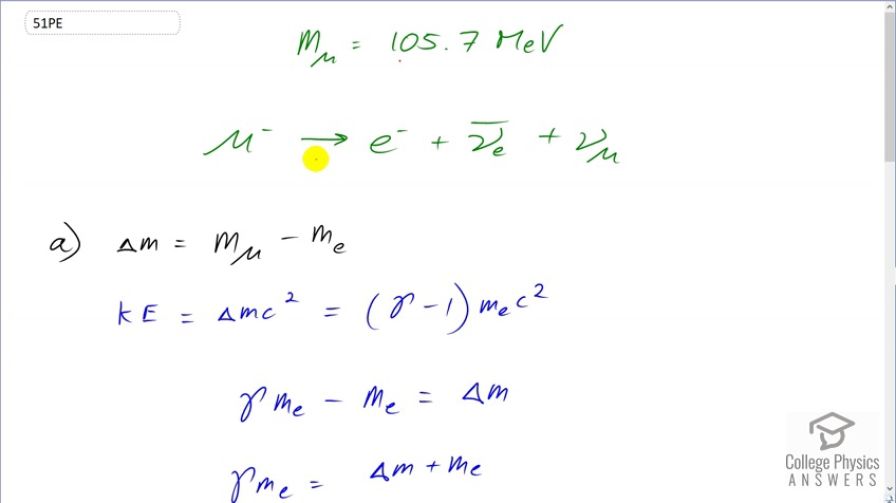Question
A muon has a rest mass energy of 105.7 MeV, and it decays into an electron and a massless particle. (a) If all the lost mass is converted into the electron’s kinetic energy, find for the electron. (b) What is the electron’s velocity?
Final Answer
Solution video
OpenStax College Physics for AP® Courses, Chapter 28, Problem 51 (Problems & Exercises)

vote with a rating of
votes with an average rating of
.
Calculator Screenshots
Video Transcript
This is College Physics Answers with Shaun Dychko. A muon has a rest mass energy of 105.7 megaelectron volts and then it spontaneously has a decay into an electron and some mass-less particles and you don't need to know what those particles are but I have just written them down anyway, it's going to be an electron anti-neutrino plus a muon neutrino. So we are told that this mass that is lost because initially there is some mass of the muon and then after decay, there's only mass of the electron and this electron mass is going to be a lot less than the initial muon mass. And so that lost mass gets turned entirely into kinetic energy of the electron we are told. And so this kinetic energy that it has is gonna be the mass that's lost times c squared. And the mass that's lost is the difference in masses of the muon and electron. And kinetic energy we also have an expression for that is gamma minus 1 times the mass of this particle which is an electron times c squared. Now the c squared's will cancel and then we have that gamma times mass of an electron minus mass of an electron equals the mass lost in the decay. In part (a), we are solving for gamma here so let's add mass of the electron to both sides. And then we have γ m e equals Δm plus m e and then we'll divide both sides by mass of the electron. So γ is Δm plus m e over m e. Now the mass lost is the difference in the muon and electron masses and so we substitute that in and we'll see that the mass of the electron disappears from the numerator and we are left with γ is the ratio of the mass of the muon to the electron. So that's 105.7 megaelectron volts divided by the rest mass energy of an electron which you can look up in a data table which is 0.5110 megaelectron volts giving us a gamma of 207. Now part (b) says what velocity does this gamma correspond to for an electron? So we have the Lorentz factor gamma is 1 over square root 1 minus v squared over c squared and we have to solve this for v. And I'm gonna raise both sides to the exponent negative 2 and then switch the sides around and so on the left side now, after we switch the sides around, we are gonna have 1 minus v squared over c squared. This negative exponent flips the fraction right so we have this square root moving into the numerator and then it's getting squared and so the square root sign disappears. On the other side, we have this fraction gamma over 1 getting flipped and so now it's 1 over gamma and then it's squared so that's 1 over gamma squared. Then we move this to the right side and move this to the left side by adding and subtracting respectively and then switch the sides around giving us v squared over c squared equals 1 minus 1 over gamma squared. Then multiply both sides by c squared and then take the square root of both sides and you have v is c times square root of 1 minus 1 over gamma squared. So that's speed of light times square root of 1 minus 1 over the gamma that we figured out in part (a) which I have written with extra digits here so 206.85 squared giving a velocity of 2.99796 times 10 to the 8 meters per second. And I have written more digits than our measurements really justify just to distinguish this velocity from c.
